

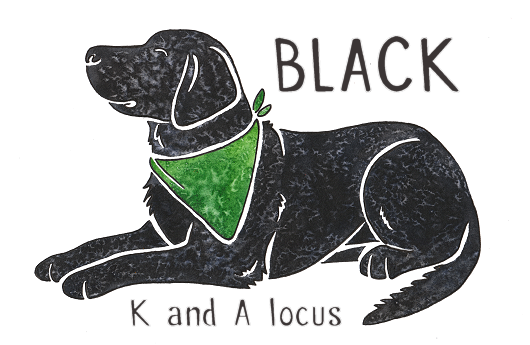

Already know what you're looking for? Quick Links |

The Dominant Black Gene
Black is the "default" eumelanin colour for dogs. A dog that isn't homozygous for liver (bb) or for dilution (dd) will have black eumelanin. This means that it will have a black nose and, usually, brown eyes (eumelanin affects eye colour too), and any eumelanin in its coat will be black. Eumelanin, in case you missed out the introduction pages, is one of two types of pigment that occur in dogs. The other is phaeomelanin, which doesn't affect the eyes or nose and is only visible in the coat. It produces the colour "red", which is anything from deep Irish Setter red to light cream. Phaeomelanin only appears in the coat if the dog has particular genes that allow it to occur, and these genes also control how it is distributed throughout the coat.

Shades of eumelanin pigment - black, liver/chocolate, blue and isabella/lilac. In some breeds, liver-coloured dogs are referred to as "red", however on this site I will only use "red" to refer to phaeomelanin (below), to avoid confusion.

Shades of phaeomelanin pigment (cream to red). On this site I'll mostly refer to phaeomelanin as red or tan.
You may notice some apparent overlap between cream shades and isabella in the eumelanin image above. Although these look similar here, the differences are actually fairly obvious when the dogs are seen side-by-side, and nose and eye colour also helps to distinguish them.

There are two basic choices for a dog's markings - solid (no red/tan markings, just eumelanin) or non-solid (red/tan markings of any sort). Whether a dog has a solid eumelanin (black) coat or a coat with red/tan markings (caused by phaeomelanin) depends almost entirely on the K locus. K consists of three alleles:
KB - dominant black (solid black, no red). Sometimes referred to as simply K.
kbr - brindle (this is dealt with on the brindle page, but for now all we need to know is that it acts as a k allele, but just adds brindle on top of any red markings).
ky - recessive non-black (will still have black nose pigment and may have black markings, but may also have red markings too). Sometimes referred to as simply k.
Because black is dominant, a dog with even just one KB gene will be solid black. A dog with two ky genes (i.e. homozygous for ky) will be able to show tan markings. These tan markings are determined by another locus, A (agouti). So basically, a genotype of kyky allows a dog to show whatever it has on the A locus. A Kbky or KBKB dog may be genetically tan-pointed or sable on the A locus, but won't be able to show those markings because of its dominant black allele/s. Dominant black dominates the whole of the A locus, but it can be modified by other genes, such as liver, dilution, greying and merle. All of these will alter the way a dominant black dog looks, but the one thing they cannot do is add phaeomelanin (red) to the coat. The only way phaeomelanin can be added to the coat of a dog with the dominant black gene is through the e gene (E locus) - recessive red. This turns a dominant black dog (or indeed, any dog) into a solid red dog with black nose pigment.
This all probably sounds very confusing at this point, and if you have no background in genetics you may not understand everything. Don't worry - we'll deal with the genes that can affect black on different pages a bit later on. For now, all you really need to know is that KBky and KBKB on the K locus produce a solid black dog. That black coat can then be changed to liver, blue, isabella or merle. A kyky dog may have some black in its coat, but it won't usually be solid black. The stuff about eumelanin and phaeomelanin is particularly confusing, but I've made sure to use those terms all throughout this site because if you can get a handle on them, you'll be able to understand dog genetics easily.

Examples of Dominant Blacks
All of these dogs are KBky or KBKB> on the K locus, making them genetically dominant black. Notice the lack of red anywhere in the coat of any of the black dogs below. If there is a reddish undercoat or scattered red hairs, the dog is most likely a very heavy sable (or similar) rather than a dominant black, so will actually be kyky. A brownish cast on the coat may, however, be due to bronzing. This can look a bit like red, but bronzing is when sunlight lightens the black hairs on a dog, and it can also be caused by dietary factors. Bronzing is generally most noticeable on long-haired and curly-coated breeds. It doesn't usually indicate that the dog is anything other than a normal solid black, but if it's particularly extensive and present while the dog is still growing, it can be due to seal (see below).

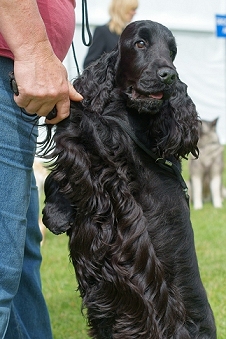
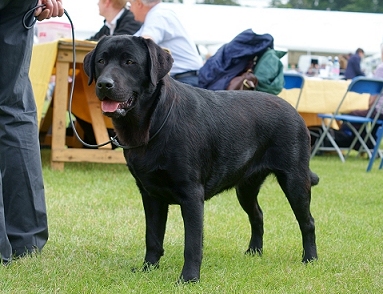
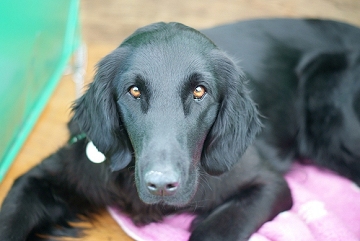
All three dogs above are dominant blacks showing no other visible genes. Dominant black is a common colour in gundogs such as these.

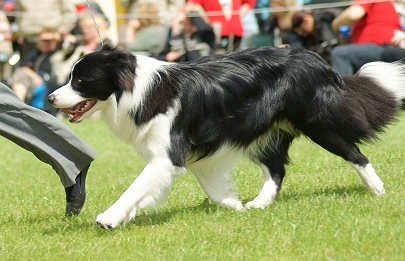
This Border Collie is a dominant black with irish spotting. Note the bronzing on the tail and ears, where the coat is longest.

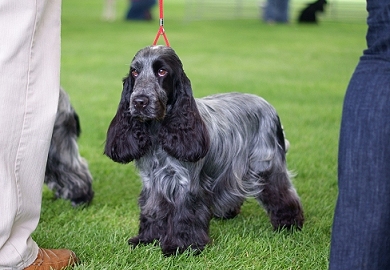
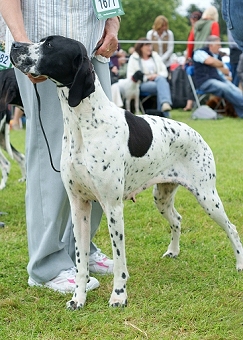
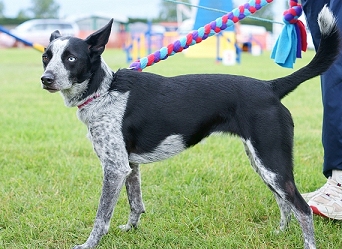
All of these dogs are dominant blacks with white in the piebald or irish spotting pattern, and ticking or roaning in the white areas.

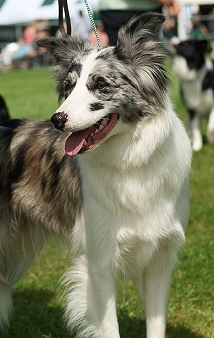
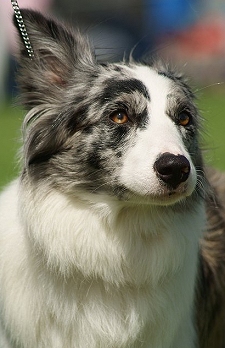
This Border Collie is also a dominant black with irish spotting, like the other Border Collie above, but this one has the merle gene too (Mm),
which has turned its black markings into broken patches on a grey base.
We know this dog is a dominant black because it has no tan markings, which we would expect to see on the cheeks and above the eyes if it was tan-pointed, or more extensively if it was sable or agouti. The brownish cast on the coat is likely due to the merling in this case, or could indicate that the dog has "hidden" or "ghost" tan markings (see below).

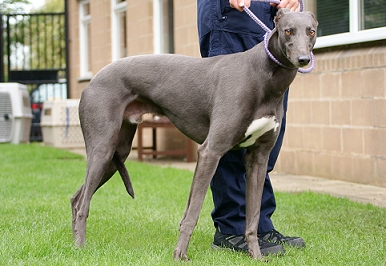
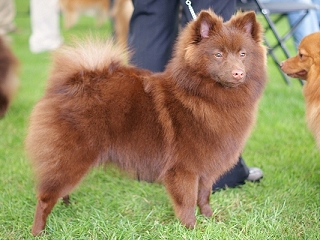
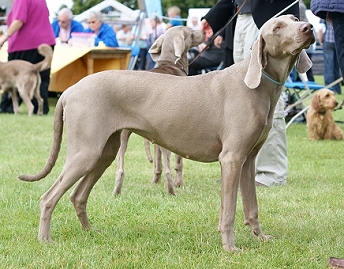
Believe it or not, these three dogs are genetically dominant blacks too, even though they don't actually have any black on them. The German Spitz
is a dominant black with the liver gene (bb), which has turned its solid black coat into brown, and the Greyhound and Weimaraner have the dilution gene (dd) added on top, making them blue and isabella respectively.
As these examples show, in the dog world it is possible to be genetically black without actually being black!

More Examples of Dominant Black
All of the following dogs are genetically dominant black, even though not all of them look black. Hover your mouse over each photo for a description of their colour.
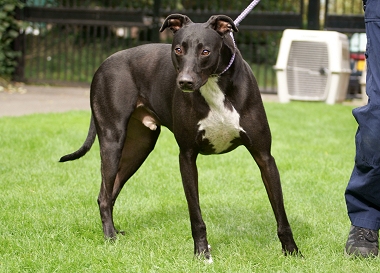

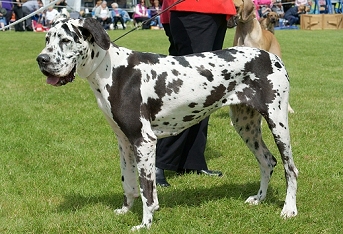
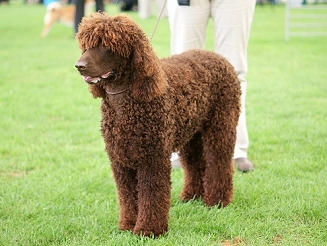
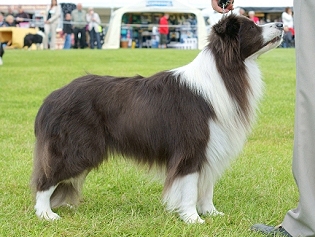
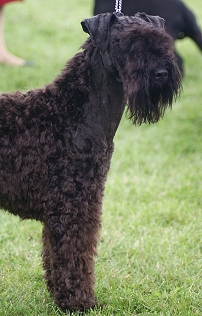
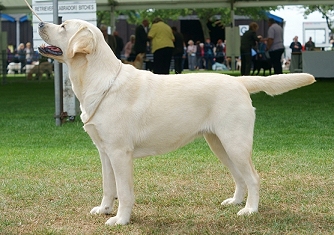
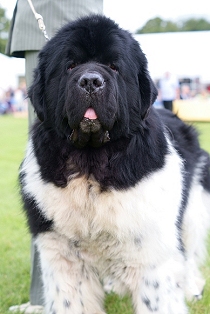
The Recessive Black Gene
Most solid black dogs have the dominant black gene described above, but there is also another, less common type of black - recessive black.
Recessive black occurs in breeds including the German Shepherd Dog, Shetland Sheepdog, Schipperke and Puli. Some breeds,
such as the Belgian Shepherd Dog, carry both recessive and dominant black. Most of the breeds that carry recessive black are herding/pastoral types, implying that it originally occurred as a mutation in a common ancestor (most likely a primitive European herding dog).
If you're wondering why the dog shown above is white, it's because Samoyeds have also been proven to have the recessive black gene. However, here it is combined with other alleles, which dilute or remove the pigment.
Recessive black is, aesthetically, no different to dominant black. The only difference is in the breeding - a solid black puppy
could be born from two parents who are non-solid black if they both carry (without expressing) one copy of the recessive black gene, whereas a dominant black pup could only
be born if one or both of its parents are also dominant blacks. Another important aspect of recessive black is that it is on a different locus to dominant black.
This makes it the only way that a dog can still be solid black if it is kyky (non-solid black) on the K locus.
Unless you're a dog breeder, recessive black is
unimportant (but it's still quite an interesting discovery!).
Seal Colouration
Seal is currently a mystery. Seal colouration makes black dogs appear brownish (with the nose remaining black), varying from a slight brown cast to a shade almost as light as liver. There is often a black stripe down the back, and the legs and tail generally remain darker than the main part of the coat. Seal dogs are born brownish whereas bronzing develops with age, and remember that a black seal will always have a black nose regardless of how light and brownish its coat is.
Seal can also be combined with other alleles to create liver/blue/isabella seal and seal merle.
"Ghost" Tan
Sometimes, a solid-coloured dog (black, liver, blue or isabella) will show faint tan markings, known as "ghost tan". Tan markings are phaeomelanin (red) "points" on the dog, usually located on the feet, under the tail, the front of the chest, the muzzle and the eyebrows. The Agouti page explains more about tan points. On a dog with "ghost" tan, these points are barely visible. It's thought that this is caused by a similar mechanism to seal (see above), where the KB allele for some reason allows the A locus allele/s to show through very faintly.
Quick Summary!
The K locus in dogs has three alleles: KB (dominant black), kbr (brindle) and ky (non-black).
Dominant black dogs (KBky or KBKB) are solid eumelanin all over, with or without white markings. The eumelanin can be modified by other genes to liver, blue, isabella or even merle, but there can't be any red/tan (phaeomelanin) in the coat except for bronzing, which is discolouration or bleaching.
kyky dogs are "non-blacks". A kyky dog will display whatever it has on its A locus (sable, tan points or agouti), which will usually be a mix of eumelanin and phaeomelanin. A kbrky or kbrkbr dog will also display whatever it has on its A locus, but any phaeomelanin in the coat will be brindled.
Most black dogs have the dominant black gene, but there's also another, less common gene that can cause solid black too - recessive black (a on the A locus).
Seal and ghost tan are caused when the A locus seems to "show through" on a dominant black dog, possibly caused by a faulty KB allele. Further Info and Links
The gene causing dominant black in dogs is known as CBD103 (Canine Beta Defensin 103). When this was discovered, it was the first time that this gene had been shown to have an effect on coat/skin colour. The human version of this gene, DEFB103a, is involved in immunity, however there doesn't seem to be any link between the K locus and health in dogs.
If you've studied the genetics of any other domestic animals then you'll probably be aware that black in almost all other mammals is recessive, making dogs more-or-less unique. Cattle also have a dominant black gene, but theirs is located on the E locus (MC1R). K-locus black is found in dogs only.
Links to studies:
** Please note that I am not a research scientist, and the information on this page comes from my own knowledge and observation of dogs, observational and testing data provided via e-mail by site visitors, any research papers linked on the page, and the information provided by Dr Sheila M. Schmutz on her excellent website http://homepage.usask.ca/~schmutz/dogcolors.html
For further genetics resources, see the Links page

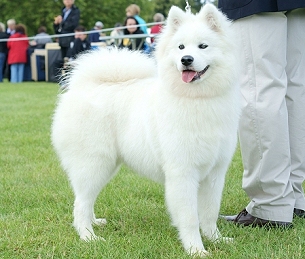
Recessive black is on the A locus. It is denoted by a, and is generally put right at the bottom of the A locus because it is recessive
to every other A locus gene (sable Ay, agouti aw, tan points at). This means that
if a dog has just one a allele, it will not be solid black (but sable, tan-pointed, etc), as it needs two a alleles for the recessive gene to work.
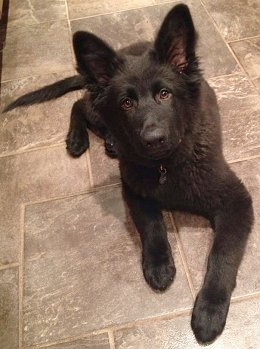
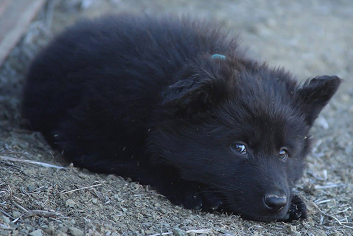
Recessive black German Shepherd Dog puppy, photos submitted by Bonnie Norwood. As you can see, recessive black looks identical to dominant black, and can come in all the same patterns and shade variations as the dominant blacks shown in the examples above, including liver, merle etc. However, recessive black will never show ghost tan or seal (see below).


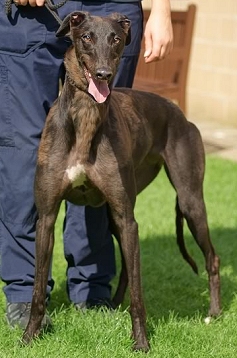
No genetic research has so far been conducted into seal, so it is unknown how it is caused or which locus is responsible for it.
Seal dogs generally test as KBky, and are usually AyAy on the A locus, so it is probable that their colouration is caused by the A locus "leaking through" the black coat. However, the mechanism for this is unknown.
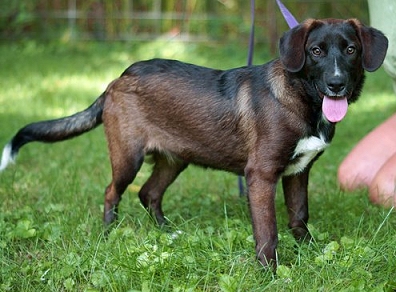
Seal mixed breed - photo by Jamie Elvert

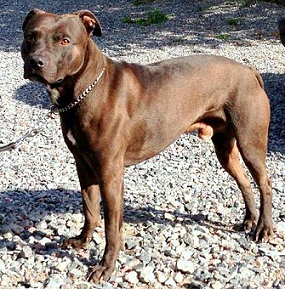
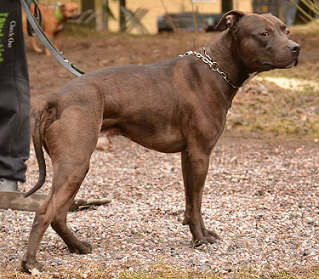
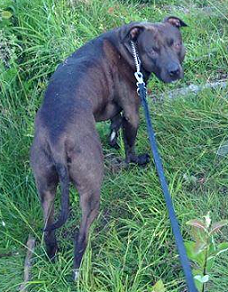
Pictures submitted by Karoliina Kalanti
This dog looks like a liver at first glance. However, the final photo shows a clear black line down the back and a black nose (albeit a fairly pale one), making this a particularly light-coloured black seal. This is a great example of how misleading photos can be when trying to determine a dog's colour, as this could very easily be mistaken for a solid liver (bb). The colour a dog looks in a photo can depend on the light conditions at the time, whether flash was used, and whether the picture has been edited at all.
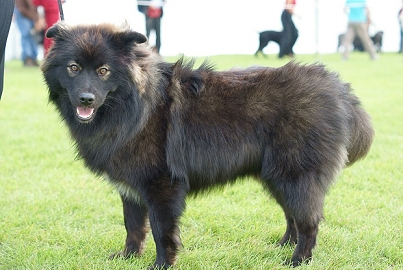
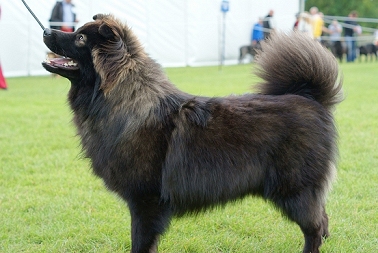
A seal-type pattern on a Finnish Lapphund. This dog also appears to have a black mask.
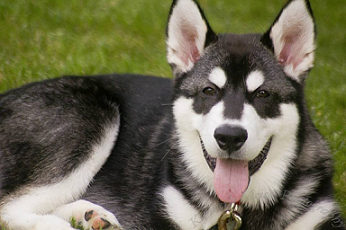
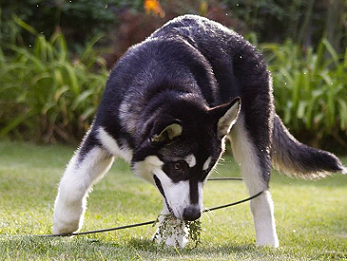
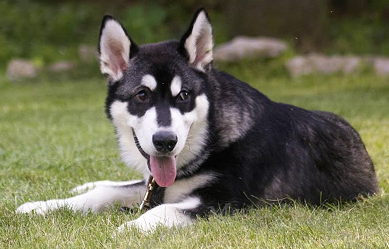
Baal the Alaskan Malamute puppy - photos by Justin Rutledge
Baal here is an example of the colouration referred to as "seal" in Alaskan Malamutes. The clear white pheaeomelanin points indicate that this isn't caused by the same mechanism as the seal dogs above. "Seal" in Alaskan Malamutes is actually caused by a combination of tan points (here diluted to white) and the Northern domino (Ed) gene.


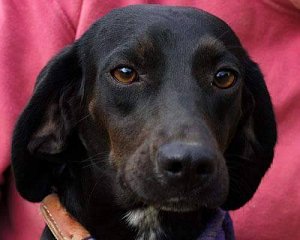
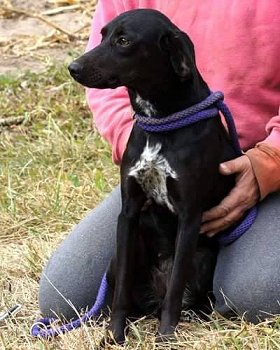
Photos by Jamie Elvert
This mixed breed shows ghost tan points. As you can see from the second photo, they are barely visible from a distance, and in dim light this dog may appear completely solid.

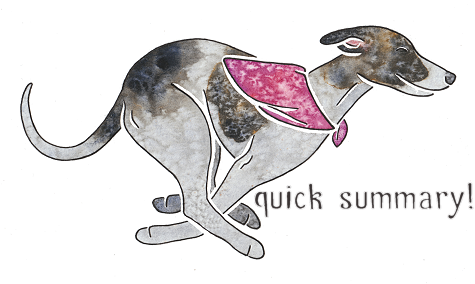
No time to read the whole thing? Here's the quick version!

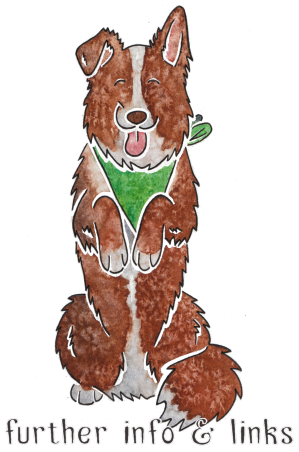
Exclusion of melanocortin-1 receptor (mc1r) and agouti as candidates for dominant black in dogs: http://www.ncbi.nlm.nih.gov/pubmed/12692166
A Beta-Defensin Mutation Causes Black Coat Color in Domestic Dogs: http://www.ncbi.nlm.nih.gov/pmc/articles/PMC2906624/

